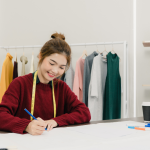Fashion design encompasses an array of diverse styles, and understanding the various types of fashion design is crucial. From haute couture to fast fashion, each type brings a distinct flair to the industry. Haute couture represents high-end, custom-made garments crafted meticulously to fit individual clients, while ready-to-wear fashion caters to a wider audience with pre-made clothing lines. These diverse types of fashion designing highlight the industry’s ability to cater to various tastes and preferences, setting trends and reflecting societal shifts.
In this blog, we’ll delve into the intricate world of fashion design, exploring its multifaceted nature. Beyond the basics, we’ll uncover the significance of fashion design, delve into different types, and shed light on the immense scope and potential it holds in India. Additionally, we’ll delve into the expected salary trends in the field for 2023, offering a comprehensive understanding of this dynamic industry’s professional landscape.
Table of content
What is Fashion Design
Types of Fashion Design
Top 5 Courses for Fashion Design
Importance of Fashion Design
How to Get into Fashion Design
Eligibility for Fashion Design After 12th
Scope in Fashion Design in India
Salary in Fashion Design in 2024
What is Fashion Design?
Fashion design spans a rich tapestry of styles, each expressing its unique ethos in the world of clothing and accessories. From the opulent intricacies of Haute Couture to the accessible appeal of Ready-to-wear, the industry pulsates with diversity. Luxury Fashion exudes exclusivity, Economy Fashion blends affordability with trends, while Fast Fashion swiftly adapts to current tastes. Understanding these distinct realms empowers aspiring designers, enabling them to navigate this dynamic landscape, innovate within each sphere, and channel their creative visions. Appreciating these types of fashion designing illuminates the multifaceted nature of the industry and opens doors to creative exploration and expression.
Types of Fashion Design
Here’s a closer look at these types:
- Haute Couture: High-end, made-to-order fashion created for individual clients with the highest level of craftsmanship. It’s often custom-made and exclusive, showcasing the pinnacle of design and luxury.
- Luxury Fashion: This includes high-quality, prestigious brands known for their exceptional craftsmanship, quality materials, and exclusivity. These brands often set trends and maintain a high price point.
- Ready-to-wear Fashion: Also known as “prêt-à-porter,” this refers to mass-produced clothing available in standard sizes and readily accessible in stores. It’s more affordable and designed for the general public.
- Economy Fashion: This category encompasses affordable, budget-friendly clothing designed for everyday wear. It’s characterized by its accessibility, simplicity, and often reflects current trends.
- Fast Fashion: This sector focuses on quickly producing affordable clothing to mimic the latest trends seen on runways or in luxury fashion. It’s known for its rapid turnover of styles and lower prices.
Each type caters to different consumer needs, preferences, and price ranges, contributing to the diverse landscape of the fashion industry.
Top 5 Courses for Fashion Design
Here are the top 5 courses for fashion design:
- AAFT Online – Diploma in Fashion Design: An expansive program covering design fundamentals, garment creation, and industry insights.
- National Institute of Fashion Technology (NIFT): Renowned for its comprehensive curriculum and cutting-edge design education.
- Pearl Academy: Offering courses in fashion styling, design, and business for holistic skill development.
- JD Institute of Fashion Technology: Providing courses in fashion, interior, and jewelry design.
- Symbiosis Institute of Design (SID): Known for its innovative design programs and emphasis on practical learning.
Importance of Fashion Design
Fashion design holds substantial significance in various domains:
- Cultural Expression: Fashion is a canvas for cultural representation, reflecting traditions, values, and societal changes. It serves as a form of communication, expressing individual identities and cultural diversity.
- Economic Impact: The fashion industry is a substantial contributor to global economies. It generates employment opportunities, fosters innovation, and contributes significantly to international trade.
- Innovation and Trends: Fashion design drives innovation, constantly evolving with new materials, techniques, and styles. It sets trends that influence consumer behavior and market demands.
- Self-Expression: It offers individuals a means of self-expression and creativity. Clothing choices allow people to showcase their personality, emotions, and affiliations.
- Social and Environmental Impact: The fashion industry has started focusing on sustainability and ethical practices. Fashion design plays a crucial role in advocating for eco-friendly materials, reducing waste, and promoting ethical manufacturing processes.
Ultimately, fashion design influences not just what people wear but also how they perceive themselves and others, making it an essential aspect of contemporary society.
How to Get into Fashion Design?
To step into the world of fashion design, consider these steps:
- Education: Pursue a degree or diploma in fashion design from reputable institutions. It provides a foundation in design principles, textiles, garment construction, and industry knowledge.
- Skill Development: Hone your skills in sketching, pattern making, sewing, and computer-aided design (CAD) software. Attend workshops, internships, or online courses to refine your craft.
- Build a Portfolio: Develop a diverse portfolio showcasing your designs, creativity, and technical abilities. Include sketches, illustrations, and finished pieces to demonstrate your range.
- Networking: Connect with professionals in the industry, attend fashion events, workshops, and seminars. Networking can open doors for internships, collaborations, and job opportunities.
- Internships and Apprenticeships: Gain practical experience through internships or apprenticeships with established designers or fashion houses. Real-world experience is invaluable.
- Stay Updated: Keep up with fashion trends, industry news, and emerging technologies. A keen understanding of the market and its evolution is essential.
- Persistence and Passion: Fashion design is competitive. Stay persistent, adapt to changes, and let your passion drive you forward, even during challenging times.
To pursue a career in fashion design after completing your 12th grade, you typically need to meet certain eligibility criteria:
- Educational Qualification: Most fashion design courses require candidates to have passed their 12th grade from a recognized board or equivalent.
- Subject Requirements: While not always mandatory, having a background in arts, design, or related subjects can be beneficial. Some institutes may prefer applicants with a specific combination of subjects.
- Minimum Marks: Some institutions might have minimum percentage or grade requirements in the 12th-grade examination for admission to their fashion design programs.
- Entrance Exams: Many fashion design schools and colleges conduct entrance exams or interviews to assess a candidate’s aptitude and skills in design, creativity, and aesthetics.
- Portfolio: Alongside meeting the academic criteria, having a strong portfolio showcasing your creative work, sketches, designs, and projects can significantly enhance your chances of admission.
Always check the specific eligibility criteria of the institute or university offering the fashion design course you’re interested in, as requirements may vary between institutions.
Scope in Fashion Design in India
The scope in fashion design in India has seen significant growth and diversification in recent years:
- Expanding Industry: India’s fashion industry has evolved, embracing global trends while also celebrating its rich cultural heritage. This expansion has led to increased opportunities for fashion designers in various sectors like apparel, accessories, textiles, and more.
- Diverse Career Paths: Fashion designers can explore various career paths such as haute couture, ready-to-wear, accessory design, textile design, costume design for films and theatre, fashion journalism, styling, and fashion entrepreneurship.
- Emerging Markets: With the rise of e-commerce and social media, there’s a growing demand for unique designs and personalization. This trend has opened avenues for budding designers to explore online retail, custom clothing, and niche markets.
- Global Recognition: Indian fashion designers are gaining global recognition, showcasing their collections at international fashion weeks and collaborating with renowned brands worldwide.
- Innovation and Sustainability: The industry is increasingly focusing on sustainability and ethical fashion. Designers incorporating eco-friendly practices and innovative techniques are gaining attention in both national and international markets.
- Entrepreneurship Opportunities: The rise of startups and the emphasis on ‘Make in India’ have created platforms for young designers to start their labels, boutiques, or design studios, tapping into the growing demand for unique and indigenous designs.
The evolving consumer preferences, coupled with India’s rich textile heritage, offer an extensive scope for aspiring fashion designers to explore and establish themselves in this dynamic industry.
Salary in Fashion Design in 2024
In 2024, fashion design salaries in India vary widely. Entry-level roles typically range from ₹3-5 lakhs annually, while mid-level positions can span between ₹6-12 lakhs. Senior positions in prestigious firms command higher pay scales. Factors like experience, specialized focus, geographic location, and the specific sector within the types of fashion designing significantly influence earning potentials for fashion designers.
Conclusion
Understanding the diverse landscape of fashion design involves delving into various genres such as Haute Couture, Luxury Fashion, Ready-to-wear, Economy Fashion, and Fast Fashion. Each style encompasses its unique characteristics, catering to different tastes and markets. Embracing these different types of fashion designing not only broadens one’s creative spectrum but also provides an insight into the dynamic nature of the industry. Aspiring designers can explore these avenues, harness their skills, and contribute to the ever-evolving world of fashion.
FAQs on Types of Fashion Designing
Q1. What are the most common types of fashion designing and how do they differ?
Fashion design covers various specializations, each with its own focus and audience. The most common types include Haute Couture, which creates exclusive, custom-made garments for elite clients; Ready-to-Wear (Prêt-à-Porter), which offers stylish but standardized clothing lines; Mass Market Fashion, focusing on affordable and accessible apparel; Eco-Fashion, which emphasizes sustainability; and Ethnic/Traditional Fashion, which highlights cultural and regional clothing. These categories differ in their target customers, level of exclusivity, price points, and design philosophy.
Q2. Why is understanding the types of fashion designing important for aspiring designers?
For aspiring designers, understanding the different branches of fashion is essential because it helps them choose a career path aligned with their skills and interests. A student passionate about creativity and craftsmanship may thrive in haute couture, while someone interested in global trends and scalability might prefer ready-to-wear or mass-market fashion. Clarity about these differences ensures designers build the right portfolio and gain the expertise needed for their chosen niche.
Q3. What career paths correspond to different types of fashion designing?
Each type of fashion designing opens up unique career opportunities. Haute couture designers often work with luxury fashion houses or establish their own labels. Ready-to-wear designers may collaborate with international brands or retail companies. Those in mass-market fashion typically join large apparel corporations, working on seasonal collections for wide consumer bases. Sustainable fashion designers may work with eco-friendly startups, ethical brands, or NGOs promoting conscious clothing. Traditional and ethnic designers often venture into boutique businesses or collaborate with artisans to keep heritage crafts alive.
Q4. How are sustainable and eco-friendly types of fashion designing evolving?
Sustainable fashion is one of the fastest-growing fields in the industry. Designers today are focusing on eco-friendly fabrics, ethical sourcing, and zero-waste production techniques. Brands are shifting toward recycled textiles, organic cotton, bamboo fibers, and plant-based dyes, ensuring minimal environmental harm. With consumers becoming more eco-conscious, designers specializing in sustainable fashion are gaining recognition globally, making it both a rewarding and socially impactful career choice.
Q5. Which of the types of fashion designing is best suited for mass-market versus haute couture audiences?
Mass-market fashion is best suited for everyday consumers who seek affordability, accessibility, and trend-driven designs. It focuses on producing large quantities of clothing at lower costs. On the other hand, haute couture caters to an exclusive audience, often celebrities, royals, and high-net-worth individuals. It emphasizes uniqueness, luxury fabrics, and hand-crafted detailing, making each piece a statement of art and status rather than just clothing.



















